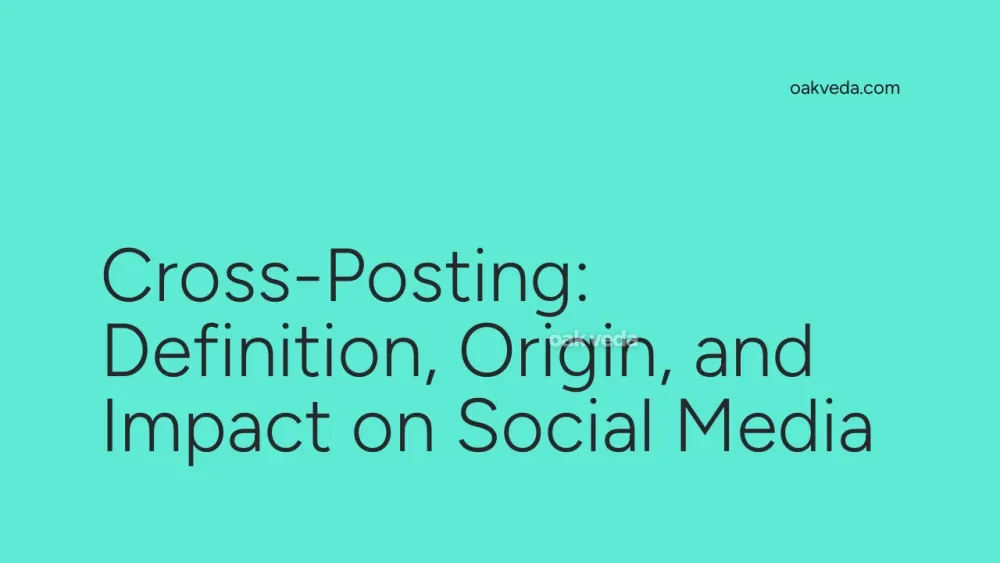
What is Cross-Posting?
Cross-posting is a social media strategy that involves sharing the same content across multiple platforms or online communities simultaneously. This technique allows users, brands, and content creators to maximize their reach and engagement by distributing a single piece of content to various audiences on different social networks.
Origin and Development of Cross-Posting
The concept of cross-posting emerged alongside the proliferation of social media platforms in the mid-2000s. As users began to maintain multiple online profiles, the need for a more efficient way to share content across these platforms became apparent. Initially, cross-posting was a manual process, but as social media management tools evolved, automated cross-posting features became increasingly common.
How Cross-Posting Works
Cross-posting typically involves the following steps:
- Content creation: Develop a post, image, video, or other content piece.
- Platform selection: Choose the social media platforms where you want to share the content.
- Adaptation (optional): Modify the content to suit each platform's specific requirements or audience preferences.
- Simultaneous posting: Share the content across all selected platforms, either manually or using a social media management tool.
Types of Cross-Posting
There are two main approaches to cross-posting:
- Direct cross-posting: Sharing identical content across multiple platforms without any modifications.
- Adapted cross-posting: Tailoring the content for each platform to optimize engagement and adhere to platform-specific best practices.
Popular Examples of Cross-Posting
Many brands and influencers use cross-posting to maintain a consistent presence across social media platforms. For example:
- News outlets often share the same headlines and article links across Twitter, Facebook, and LinkedIn.
- Celebrities frequently post the same photos or announcements on Instagram, Twitter, and Facebook to reach their entire fan base.
- E-commerce businesses may share product promotions across multiple platforms to maximize visibility during sales events.
Impact of Cross-Posting on Social Media Culture
Cross-posting has significantly influenced social media culture in several ways:
- Content homogenization: The prevalence of cross-posting has led to increased content similarity across platforms.
- Efficiency in content distribution: It has made it easier for individuals and brands to maintain an active presence on multiple platforms.
- Platform-specific adaptations: As users become more aware of cross-posting, there's a growing emphasis on tailoring content to each platform's unique features and audience expectations.
Controversies and Debates Surrounding Cross-Posting
While cross-posting offers numerous benefits, it has also sparked debates within the social media community:
- Quality vs. quantity: Critics argue that cross-posting prioritizes quantity over quality, potentially leading to less engaging content.
- Platform authenticity: Some users feel that cross-posting diminishes the unique culture and experience of individual platforms.
- Audience fatigue: Followers who are active on multiple platforms may become frustrated by seeing repetitive content.
How Brands and Influencers Use Cross-Posting
Brands and influencers leverage cross-posting to:
- Increase reach: By sharing content across multiple platforms, they can connect with a broader audience.
- Save time: Cross-posting reduces the need to create unique content for each platform.
- Maintain consistency: It helps in delivering a unified brand message across various social media channels.
- Drive traffic: Cross-posting can direct users from one platform to another, increasing overall engagement.
To maximize the effectiveness of cross-posting, many adopt a hybrid approach:
- Core message consistency: Maintain the main message or theme across all platforms.
- Platform-specific optimization: Adjust content format, length, and style to suit each platform's best practices.
- Varied posting schedules: Stagger post times to avoid overwhelming followers who are active on multiple platforms.
Future Trends Related to Cross-Posting
As social media continues to evolve, several trends are shaping the future of cross-posting:
- AI-powered content adaptation: Advanced tools are emerging that can automatically optimize content for different platforms.
- Increased integration: Social media platforms are likely to offer more seamless cross-posting features to retain users.
- Focus on native content: There's a growing emphasis on creating platform-specific content, even within a cross-posting strategy.
- Analytics-driven approach: More sophisticated analytics tools will help users refine their cross-posting strategies based on performance data.
FAQs about Cross-Posting
Q: Is cross-posting good for SEO? A: While cross-posting can increase visibility, it's important to avoid duplicate content issues. Use canonical tags or platform-specific adaptations to maintain SEO benefits.
Q: How often should I cross-post? A: The frequency depends on your audience and content type. Generally, it's best to balance cross-posted content with platform-specific posts to maintain engagement.
Q: Can cross-posting hurt my social media performance? A: If not done thoughtfully, cross-posting can lead to lower engagement rates. To avoid this, tailor your content to each platform and avoid over-posting.
Q: What are the best tools for cross-posting? A: Popular tools include Hootsuite, Buffer, Later, and Sprout Social. These platforms offer scheduling and analytics features to optimize your cross-posting strategy.
In conclusion, cross-posting is a powerful tool in the social media marketer's arsenal. When used strategically, it can significantly amplify your message and streamline your content distribution process. However, it's crucial to balance efficiency with platform-specific optimization to ensure your cross-posting efforts enhance rather than hinder your social media presence.
You may be interested in:
- Marketing Proposal: Definition, Origin, and Impact
- Deinfluencing: Definition, Origin, and Impact on Social Media
- Face Card: Definition, Origin, and Impact on Social Media
- A/B Testing: Definition, Origin, and Impact on Social Media
- TBT: Definition, Origin, and Impact on Social Media Culture
- Fan-Girl: Definition, Origin, and Impact on Social Media

